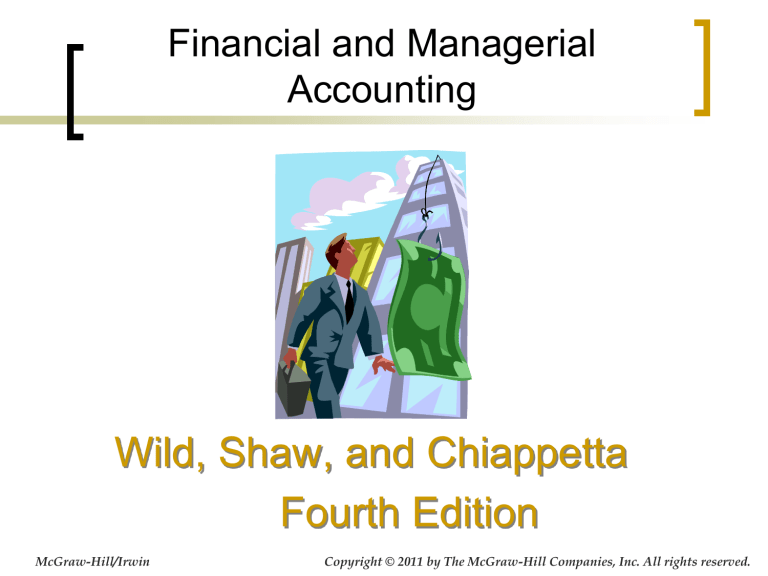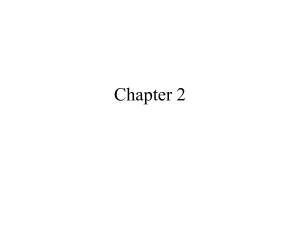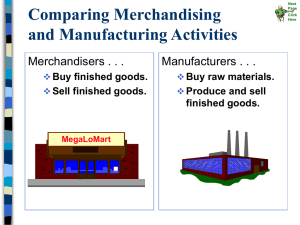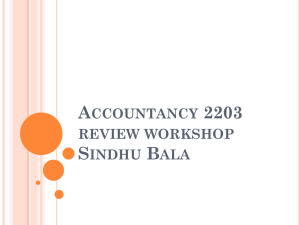
Financial and Managerial
Accounting
Wild, Shaw, and Chiappetta
Fourth Edition
McGraw-Hill/Irwin
Copyright © 2011 by The McGraw-Hill Companies, Inc. All rights reserved.
Chapter 14
Managerial Accounting
Concepts and Principles
Conceptual Learning Objectives
C1: Explain the purpose and nature of managerial
accounting and the role of ethics.
C2: Describe accounting concepts useful in classifying
costs.
C3: Define product and period costs and explain how
they impact financial statements.
C4: Explain how the balance sheets and income
statements for manufacturing and merchandising
companies differ.
C5: Explain manufacturing activities and the flow of
manufacturing costs.
C6: Identify trends in managerial accounting.
14-3
Analytical Learning Objectives
A1: Compute cycle time and cycle
efficiency, and explain their importance
to production management.
14-4
Procedural Learning Objectives
P1: Compute cost of goods sold for a
manufacturer.
P2: Prepare a manufacturing statement
and explain its purpose and links to
financial statements.
14-5
C1
Managerial and Financial
Accounting
Managerial accounting
provides financial and
non-financial information
for managers of an
organization and other
decision makers
Financial accounting
provides general
purpose financial
information to those
who are outside
the organization.
14-6
Nature of Managerial
Accounting
C1
Financial Accounting
Managerial Accounting
Investors, creditors and
other external users
Managers, employees and
other internal users
2. Purpose of
information
Making investment, credit
Planning and
and other decisions
control decisions
3. Flexibility
of practice
Structured and often
Relatively flexible
controlled by GAAP
(no GAAP constraints)
4. Timeliness of
information
Often available only
Available quickly without
after audit is complete
need to wait for audit
Historical information
with some predictions
Many projections
and estimates
Emphasis on
Projects, processes and
whole organization
segments of an organization
Monetary
Monetary and
information
nonmonetary information
1. Users and
decision makers
5. Time dimension
6. Focus of
information
7. Nature of
information
14-7
C2
Managerial Cost Concepts
Behavior
Traceability
Controllability
Relevance
Function
14-8
C2
Classification by Behavior
Cost behavior means how a cost will
react to changes in the level of
business activity.
A fixed cost does not change with
changes in the volume of activity
A variable cost changes in
proportion to changes in the volume
of activity
A mixed cost refers to a combination of
fixed and variable
14-9
C2
Classification by Traceability
Direct costs
Costs traceable to a
single cost object.
Examples: material
and labor cost for a
product.
Indirect costs
Costs that cannot be
traced to a single cost
object.
Example:
maintenance
expenditures
benefiting two or more
departments.
14-10
C2
Classification by Controllability
The degree of control depends on the
level of management in the organization.
Very little control
14-11
C2
Classification by Relevance:
Sunk Costs
All costs incurred in the past that cannot be avoided
or changed.
Sunk costs should not be considered in decisions.
Example: You bought an automobile that cost
$15,000 two years ago. The $15,000 cost is
sunk because whether you drive it, park it, trade
it, or sell it, you cannot change the $15,000
cost.
14-12
C2
Classification by Relevance:
Out-of-Pocket Costs
A cost that requires a future outlay of cash.
Out-of-pocket costs should be considered in
decisions.
Example: You plan on buying a new car for
$25,000 next month. The cost of the new car is
an out-of-pocket cost because you can choose
to spend the $25,000 or not in the future
14-13
C2
Classification by Relevance:
Opportunity Costs
The potential benefit lost by choosing a
specific action from two or more alternatives
Example: If you were not attending
college, you could be earning $20,000 per
year. Your opportunity cost of attending
college for one year is $20,000.
14-14
C3
Classification by Function:
Product Costs
Direct
Material
Direct
Labor
Manufacturing
Overhead
The
Product
14-15
C3
Period and Product Costs
in Financial Statements
Period Costs
(Expenses)
2011 Income
Statement
Operating
Expenses
2011 Costs
Incurred
Cost of
Goods Sold
Product
Costs
(Inventory)
Inventory
Sold in 2011
Inventory Not
Sold in 2011
2011 Balance
Sheet Inventory
Raw Materials
Goods in Process
Finished Goods
2012 Income
Statement
Cost of
Goods Sold
14-16
Balance Sheet of a
Manufacturer
C4
Raw
Materials
Materials
waiting to be
processed.
Can be direct
or indirect.
Goods in
Process
Partially complete
products.
Material to which
some labor and/or
overhead have
been added.
Finished
Goods
Completed
products
for sale.
14-17
Income Statement of a
Manufacturer
C4
Merchandiser
Manufacturer
Beginning
Merchandise
Inventory
Beginning
Finished Goods
Inventory
+
+
Cost of Goods
Purchased
_
The major
difference
Ending
Merchandise
Inventory
=
Cost of Goods
Manufactured
_
Ending
Finished Goods
Inventory
Cost of Goods
Sold
=
14-18
P1
Income Statement of a
Manufacturer
Cost of goods sold for manufacturers differs only
slightly from cost of goods sold for
merchandisers.
Merchandising Company
Cost of goods sold:
Beg. merchandise
inventory
+ Purchases
= Goods available
for sale
- Ending
merchandise
inventory
= Cost of goods
sold
$ 14,200
234,150
$ 248,350
(12,100)
$ 236,250
Manufacturing Company
Cost of goods sold:
Beg. finished
goods inv.
+ Cost of goods
manufactured
= Goods available
for sale
- Ending
finished goods
inventory
= Cost of goods
sold
$11,200
170,500
181,700
(10,300)
$
171,400
14-19
C5
Direct Materials Used
Direct Materials
Materials that are separately and readily
traced to a particular product.
Example:
Steel used to
manufacture
the automobile.
14-20
C5
Income Statement of a
Manufacturer
Direct Labor
Labor costs that are separately and
readily traced to finished product.
Example:
Wages paid to an
automobile assembly
worker.
14-21
C5
Income Statement of a
Manufacturer
Factory Overhead
All manufacturing costs except
direct material and direct labor
Factory costs that cannot be
separately or readily traced directly to
products.
Examples:
Indirect labor – maintenance
Indirect material – cleaning supplies
Factory utility costs
Supervisory costs
14-22
Income Statement of a
Manufacturer
C5
Manufacturing costs are often
combined as follows:
Direct
Material
Direct
Labor
Prime
Cost
Manufacturing
Overhead
Conversion
Cost
14-23
Flow of Manufacturing
Activities
C5
Materials
activity
Raw
Materials
Beginning
Inventory
Raw
Materials
Purchases
Production activity
Sales activity
Goods in Process
Beginning Inventory
Finished Goods
Beginning Inventory
Direct Labor
Cost of Goods
Manufactured
Factory
Overhead
Raw Materials
Used
Raw Materials
Ending Inventory
Finished
Goods
Ending
Inventory
Cost
of
Goods
Sold
Goods in Process
Ending Inventory
14-24
P2
Manufacturing Statement
Summarizes the types and amounts of costs
Incurred in a company’s manufacturing process.
+
+
=
+
–
=
Direct Materials Used
Direct Labor
Factory Overhead
Total Manufacturing Costs
Beginning Work in Process
Ending Work in Process
Cost of Goods Manufactured
14-25
P2
Manufacturing Statement
ROCKY MOUNTAIN BIKES
Manufacturing Statement
For Year Ended December 31, 2011
Direct materials used in production
$
Direct labor
Total factory overhead costs
85,500
60,000
30,000
Total manufacturing costs for the period
Add: Beginning goods in process inventory
$
175,500
2,500
Total cost of goods in process
Deduct: Ending goods in process inventory
$
178,000
7,500
Cost of goods manufactured
$
170,500
14-26
P2
Computation of Cost of Direct Material Used
Beginning raw materials inventory
Add: Purchases of raw materials
$
8,000
86,500
Cost of raw materials available for use
Deduct: Ending raw materials inventory
$ 94,500
9,000
ROCKY
MOUNTAIN
BIKES
Cost of direct materials
used
in production
$ 85,500
Manufacturing Statement
For Year Ended December 31, 2011
Direct materials used in production
$
Direct labor
Total factory overhead costs
85,500
60,000
30,000
Total manufacturing costs for the period
Add: Beginning goods in process inventory
$
175,500
2,500
Total cost of goods in process
Deduct: Ending goods in process inventory
$
178,000
7,500
Cost of goods manufactured
$
170,500
14-27
P2
Manufacturing Statement
Include all direct labor
costs
incurred
during
the
ROCKY
MOUNTAIN
BIKES
current period.
Manufacturing
Statement
For Year Ended December 31, 2011
Direct materials used in production
$
Direct labor
Total factory overhead costs
85,500
60,000
30,000
Total manufacturing costs for the period
Add: Beginning goods in process inventory
$
175,500
2,500
Total cost of goods in process
Deduct: Ending goods in process inventory
$
178,000
7,500
Cost of goods manufactured
$
170,500
14-28
P2
Computation of Total Manufacturing Overhead
Indirect labor
$
9,000
Manufacturing Statement
6,000
Factory supervision
Factory utilities
2,600
Property taxes, factory building
1,900
Factory supplies usedROCKY MOUNTAIN BIKES 600
Factory insurance expired
1,100
Manufacturing Statement
Depreciation, building and equipment
5,300
For Year Ended December 31, 2008
Other factory overhead
3,500
Total factory
overhead
Direct
materials
usedcosts
in production
$
30,000
$
Direct labor
Total factory overhead costs
85,500
60,000
30,000
Total manufacturing costs for the period
Add: Beginning goods in process inventory
$
175,500
2,500
Total cost of goods in process
Deduct: Ending goods in process inventory
$
178,000
7,500
Cost of goods manufactured
$
170,500
14-29
P2
Manufacturing Statement
Beginning work in
process inventory is
ROCKY MOUNTAIN
BIKESover from the
carried
Manufacturing Statement
prior period.
For Year Ended December 31, 2009
Direct materials used in production
$
Direct labor
Total factory overhead costs
85,500
60,000
30,000
Total manufacturing costs for the period
Add: Beginning goods in process inventory
$
175,500
2,500
Total cost of goods in process
Deduct: Ending goods in process inventory
$
178,000
7,500
Cost of goods manufactured
$
170,500
14-30
P2
Manufacturing Statement
Ending work in process inventory
contains
the cost ofBIKES
unfinished goods,
ROCKY MOUNTAIN
and
is reportedStatement
in the current assets
Manufacturing
of the balance
sheet.
For Yearsection
Ended December
31, 20009
Direct materials used in production
$
Direct labor
Total factory overhead costs
85,500
60,000
30,000
Total manufacturing costs for the period
Add: Beginning goods in process inventory
$
175,500
2,500
Total cost of goods in process
Deduct: Ending goods in process inventory
$
178,000
7,500
Cost of goods manufactured
$
170,500
14-31
C6
Lean Practices
Customer
Orientation
in a Global
Economy
14-32
C6
Total Quality Management
Quality improvement
applied to all aspects of
business activities.
Seek and uncover
waste.
on
Employees encouraged
to try new methods
to improve quality.
Company emphasizes
value of quality through
quality awards.
14-33
Just-In-Time (JIT)
Manufacturing
C6
Receive
customer
orders.
Complete products
just in time to
ship to customers.
Schedule
production.
Receive materials
just in time for
production.
Complete parts
just in time for
assembly into products.
14-34
C6
Just-In-Time (JIT)
Manufacturing
To accomplish just-in-time
manufacturing:
Processes must be
aligned to eliminate
delays and
inefficiencies
Companies must
establish good
relations with
suppliers
14-35
A1
Cycle Time and Cycle Efficiency
Cycle Time =
Process Time +
Inspection Time +
Move Time +
Wait Time
Cycle Efficiency = Value-added time
Cycle Time
14-36
C1
Fraud in Accounting
Fraud is the use of one’s job for personal
gain through the deliberate misuse of the
employer’s assets.
It is estimated that 7% of annual revenues
are lost to fraud.
All fraud is committed to provide direct or
indirect benefit to the perpetrator, violates
the employee’s duty to his/her employer,
costs the employer money, and is carried
out in secret.
14-37
C1
Ethics in Accounting
Ethics are beliefs that distinguish right from wrong.
They are accepted standards of good and bad
behavior.
The IMA’s Statement of Ethical Professional Practice
requires management accountants to be competent,
maintain confidentiality, act with integrity, and
communicate information in a fair and credible
manner.
The Sarbanes-Oxley Act requires each issuer of
securities to disclose whether it has adopted a code of
ethics for its senior officers and the content of that
code.
14-38
End of Chapter 14
14-39









